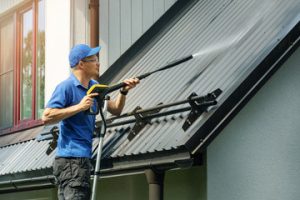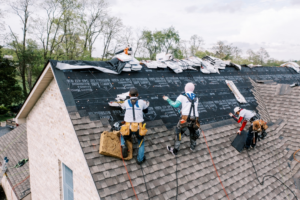A clean roof adds curb appeal, and is one of the best ways to enhance your home’s appearance. It also helps reduce energy costs and prolongs the lifespan of your roofing materials.

Regular cleaning removes moss, algae, lichen and other organic growth that degrades roofing materials, leading to leaks and structural damage. Safe and effective roof cleaning requires a thorough inspection and the right equipment. Contact Summerville Roof Cleaning for professional help.
Debris buildup on a roof can damage it, and if left unchecked it can lead to water damage within the home. Roof debris removal is an essential part of the cleaning process and it helps extend the lifespan of shingles and other roofing materials.
Debris can be organic, like leaves and twigs, or inorganic, such as garbage. Organic debris traps moisture, which can promote mildew and mold growth, as well as deteriorate the shingles. It can also clog gutters, leading to overflow and water penetration. Regular debris removal minimizes the risk of these issues and protects your investment.
Leaves, pine needles and other organic material build up quickly on a roof, especially in areas with many nearby trees. When it rains, these materials can blow onto the roof and clog gutters. This can lead to water pooling and overflow, which can cause shingle damage and interior leaks. Leaving this material on your roof can also affect insulation and increase energy bills.
Non-organic debris like dirt and twigs can also accumulate on the roof and may dislodge or break shingles. A vacuum or broom can be used to gently sweep away loose debris. It is important to inspect the entire roof while removing debris, as damaged or cracked shingles should be repaired.
If significant debris accumulation or moss, algae, or mold growth is present, it is best to call in the professionals. They can use a specialized cleaning solution that doesn’t harm shingles or other roofing materials. They can also utilize a power washer or a low-pressure spray to thoroughly clean the roof.
During this time, it is important to stay hydrated and take frequent breaks. It is recommended to wear safety equipment, such as a hard hat and gloves, when working on the roof. If you choose to do the cleaning yourself, make sure to clear the surrounding area of debris to provide a safe workspace. It is also important to use a ladder that extends far enough up the roof to allow safe access. It is also important to keep the ladder stable, not leaning against shingles or other materials.
Power Washing
A filthy roof does not only turn off potential buyers, but may also send the message that the home is neglected and in need of serious repair. On the other hand, a clean roof speaks of a well-maintained property and can help drive up the asking price. This heightened value is a major benefit of consistent professional cleaning.
In addition, regular washing removes wet leaves, twigs, and seeds that contribute to the growth of organic materials on your roof. It also helps in minimizing shade and moisture on the surface, which can lead to the development of mold, mildew, and moss.
When these contaminants are left untreated, they can penetrate under shingles and tiles and cause structural damage and shorten their lifespan. By following a maintenance schedule, you can prevent such problems and save on costly replacements.
During a power washing, professionals can also use the washer to remove unsightly stains from your home’s brick walls, aluminum siding, paver stones, and outside concrete. The washing process helps restore their color and makes them appear newer, while also revealing any areas that need repair.
Aside from protecting your home’s investment, a clean roof also boosts the overall curb appeal of your property. Regular washing can also remove discoloration from weather conditions like storms and hurricanes, as well as the build-up of soot, dirt, grime, and other debris. It can also help in removing fungus, algae, and moss.
If you have a shingle or tile roof, it is important to hire a professional who uses soft wash for the cleaning. This method uses low-pressure rinsing that is combined with a biodegradable solution to remove debris and kill organisms on the spot without damaging your roof. It also minimizes water usage and can be used on a variety of surfaces, including stucco, wood, metal, clay, or concrete.
While many homeowners prioritize interior cleaning, it is equally important to take care of the exterior of your home, starting with the roof. Regularly scheduled cleaning helps to protect your investment and ensure that it is in good condition for years to come.
Gutter Cleaning
The gutter system carries rainwater or snow/ice melt from the roof to the ground with downspouts diverting it away from the foundation, siding, and landscaping. Clogged gutters hinder this process, resulting in water damage that can threaten the integrity of your home’s structure and its value. Gutter cleaning prevents this from occurring by removing debris and ensuring water is channeled effectively away from the house.
Gutter cleaning consists of a variety of tasks including clearing any loose leaves, seeds, twigs, or pine needles from the gutters and downspouts, flushing the gutter system with water, and inspecting it for rust, wear, cracks, or other signs of damage. It also involves removing any algae or moss growing from the roof and gutters. Professionals use high-powered air blowers, extension poles, and hand tools to efficiently clear the entire surface area of your roof. The length of your roof, its height, and the extent of moss/algae growth will affect how long it takes to complete the task.
During the cleaning process, professionals will also trim overhanging branches to reduce shade and moisture on the roof, which is favorable for moss and algae growth. Afterward, they will apply a solution that eradicates moss and algae while protecting the roofing materials. This is followed by rinsing the roof with low-pressure water to remove dirt and other contaminants.
Regular roof and gutter cleaning can minimize or avoid costly repairs, protect the longevity of your roof, improve your property’s curb appeal, and keep pest infestations at bay. For optimal results, schedule your gutter and roof cleaning services together.
A homeowner in Bothell preparing to sell their home needed to boost its curb appeal and resale value before listing it. Grace Roof & Gutter Cleaning removed dark streaks and unattractive stains to transform the appearance of their property in just one service visit. The results were spectacular and added significant resale value.
Inspection
If you’re a homeowner, you already know that keeping up with regular maintenance is essential to protecting your home investment. This includes cleaning the roof, gutters, and drainage systems. But what you might not know is that professional roof cleaning can help extend the life of your roofing materials. This service goes beyond surface cleaning and includes inspections, debris removal, and even a repair process for small leaks or loose shingles.
The first step of any good roof cleaning is a visual inspection to identify what type of buildup is present and the condition of the underlying roofing material. This will also help you choose the best method for cleaning. Choosing a soft-bristle brush or cleaning pad for metal surfaces and a low-pressure power washer that’s formulated for roofs can reduce the risk of damaging your roofing material. Also, consider using a biodegradable cleaner that’s safe for the environment.
Once the moss, algae, and dirt have been removed, it’s time to start the actual cleaning process. Begin by soaking the roof with a solution that’s formulated for metal roofing. Then, scrub the roof surface in small sections with a soft-bristle brush and a low-pressure power washer, taking care not to damage shingles or tiles. Finally, rinse the roof with a garden hose to remove all the grime and cleaning solution residue.
Inspect the roof for areas that need further attention after each section has been completed. This may include rust spots, loosened or missing shingles, and damaged gutters. It’s important to catch any problems proactively, as these can often lead to expensive repairs down the road.
Regular maintenance and professional roof cleaning can protect your home’s value, enhance its appearance, and keep it in top condition. But, a thorough preventative maintenance strategy must also include trimming overhanging tree branches to limit the amount of shade and moisture that’s deposited on the roof.
